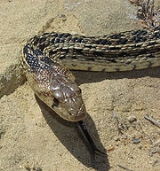
Pituophis catenifer
Encyclopedia
- Common name: Pacific gopher snake, coast gopher snake, western gopher snake, more.
Pituophis catenifer is a harmless colubrid species
Species
In biology, a species is one of the basic units of biological classification and a taxonomic rank. A species is often defined as a group of organisms capable of interbreeding and producing fertile offspring. While in many cases this definition is adequate, more precise or differing measures are...
found in North America
North America
North America is a continent wholly within the Northern Hemisphere and almost wholly within the Western Hemisphere. It is also considered a northern subcontinent of the Americas...
. Six subspecies
Subspecies
Subspecies in biological classification, is either a taxonomic rank subordinate to species, ora taxonomic unit in that rank . A subspecies cannot be recognized in isolation: a species will either be recognized as having no subspecies at all or two or more, never just one...
are currently recognized, including the nominate subspecies described here. The specific name catenifer is Latin for 'chain bearing', referring to the dorsal color pattern.
Description
Adults specimens are 36-84 inches (91–213 cm) in length. Dorsally they are yellowish or pale brown, with a series of large dark brown or black blotches, and smaller dark spots on the sides. Ventrally they are yellowish, either uniform or with brown markings.Behavior
The Gopher snake has an odd defense mechanism, in which it will puff its body up and curl itself into the classic strike pose of the pit viper genus, but rather than an open mouthed strike, the gopher snake is known for striking with a closed mouth, using its blunt nose to "warn-off" possible predators.Common names
Pacific gopher snake, coast gopher snake, bull snake, Churchill's bull snake, Oregon bull snake, Pacific pine snake, western bull snake, western gopher snake, western pine snake, yellow gopher snake.Subspecies
| Subspecies | Taxon author | Common name | Geographic range |
|---|---|---|---|
| P. c. affinis Pituophis catenifer affinis The Sonoran Gopher Snake is a subspecies of the nonvenomous Gopher Snake, a colubrid found throughout the southwestern United States.-Geographic range:... |
(Hallowell, 1852) | Sonoran gopher snake | |
| P. c. annectens | Baird Spencer Fullerton Baird Spencer Fullerton Baird was an American ornithologist, ichthyologist and herpetologist. Starting in 1850 he was assistant-secretary and later secretary of the Smithsonian Institution in Washington, D.C... & Girard Charles Frédéric Girard Charles Frédéric Girard was a French biologist specializing in ichthyology and herpetology.Born in Mulhouse, France, he studied at the College of Neuchâtel, Switzerland as a student of Louis Agassiz. In 1847, he accompanied Agassiz as his assistant to Harvard... , 1853 |
San Diego gopher snake | |
| P. c. catenifer | (Blainville Henri Marie Ducrotay de Blainville Henri Marie Ducrotay de Blainville was a French zoologist and anatomist.Blainville was born at Arques, near Dieppe. In about 1796 he went to Paris to study painting, but he ultimately devoted himself to natural history, and attracted the attention of Georges Cuvier, for whom he occasionally... , 1835) |
Pacific gopher snake | The United States United States The United States of America is a federal constitutional republic comprising fifty states and a federal district... , from Oregon Oregon Oregon is a state in the Pacific Northwest region of the United States. It is located on the Pacific coast, with Washington to the north, California to the south, Nevada on the southeast and Idaho to the east. The Columbia and Snake rivers delineate much of Oregon's northern and eastern... west of the Cascade Range Cascade Range The Cascade Range is a major mountain range of western North America, extending from southern British Columbia through Washington and Oregon to Northern California. It includes both non-volcanic mountains, such as the North Cascades, and the notable volcanoes known as the High Cascades... , south into California California California is a state located on the West Coast of the United States. It is by far the most populous U.S. state, and the third-largest by land area... , west of the Sierra Nevada to northern Santa Barbara County Santa Barbara County, California Santa Barbara County is a county located in the southern portion of the U.S. state of California, on the Pacific coast. As of 2010 the county had a population of 423,895. The county seat is Santa Barbara and the largest city is Santa Maria.-History:... and the Tehachapi Mountains Tehachapi Mountains The Tehachapi Mountains , regionally also called The Tehachapis, are a mountain range in the Transverse Ranges system of California in the Western United States... . |
| P. c. deserticola Pituophis catenifer deserticola The Great Basin Gopher Snake is a species of small colubrid snake native to the western part of the United States. The Great Basin Gopher Snake can be found all over the west including some areas of Canada and Mexico... |
Stejneger Leonhard Hess Stejneger Leonhard Hess Stejneger was a Norwegian-born American ornithologist, herpetologist and zoologist. Stejneger specialized in vertebrate natural history studies. He gained his greatest reputation with reptiles and amphibians.... , 1893 |
Great Basin gopher snake | |
| P. c. pumilis | Klauber Laurence Monroe Klauber Laurence M. Klauber , was an American herpetologist, and was considered to be the foremost authority on rattlesnakes... , 1946 |
Santa Cruz gopher snake | |
| P. c. sayi | (Schlegel Hermann Schlegel Hermann Schlegel was a German ornithologist and herpetologist.-Early life and education:Schlegel was born at Altenburg, the son of a brassfounder. His father collected butterflies, which stimulated Schlegel's interest in natural history... , 1837) |
Bullsnake | Central and western North America. |

